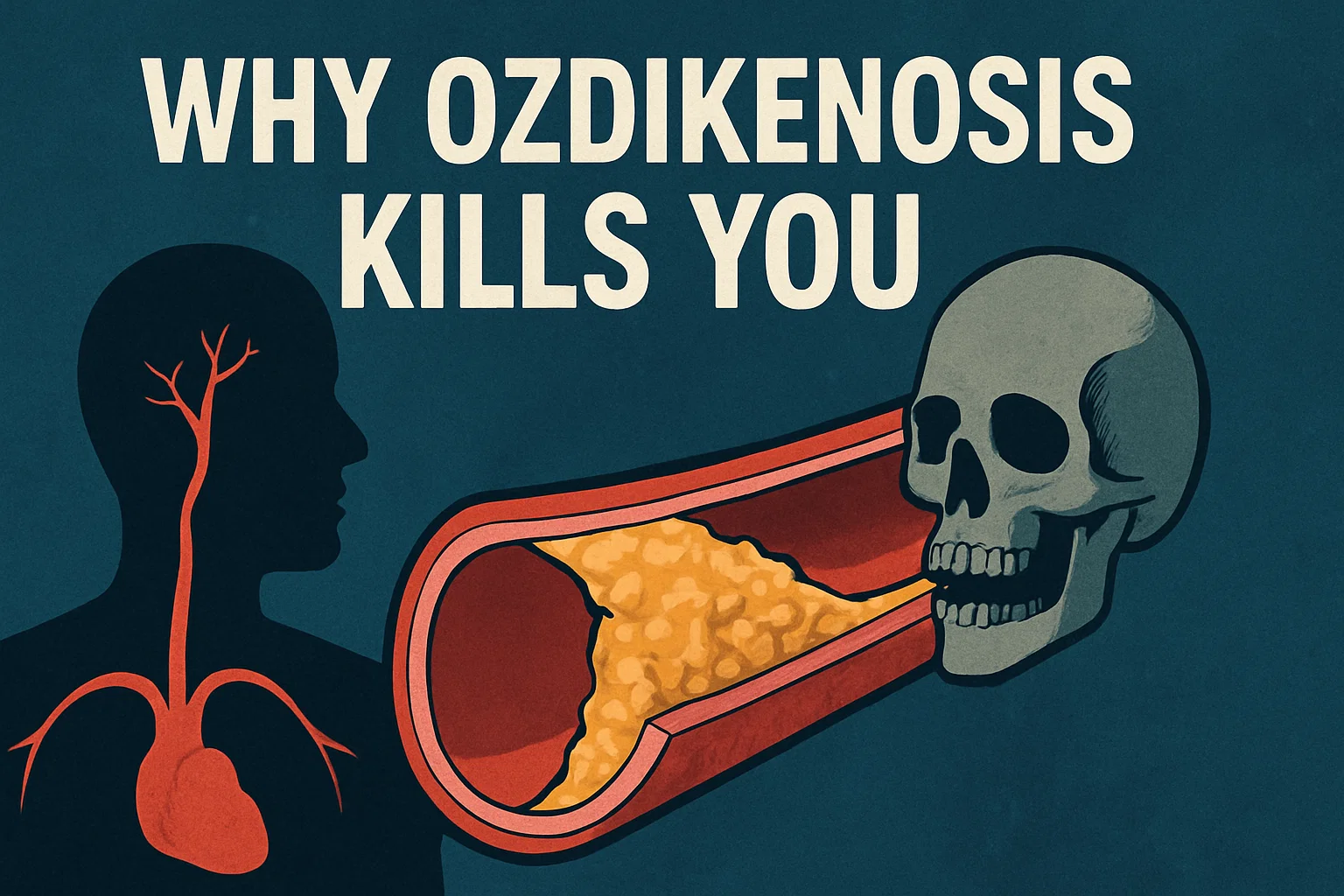Health
Why Does Ozdikenosis Kill You – The Hidden Truth About a Mysterious Fatal Disease

The question why does ozdikenosis kill you has gained attention as more people encounter references to this mysterious and deadly disease online. Ozdikenosis is described as an extremely rare, degenerative condition that attacks the body at a cellular level, leading to a slow but inevitable breakdown of vital organs. While it has not yet been fully recognized in mainstream medical literature, the available information portrays it as a devastating disorder that leaves no system untouched.
In simple terms, ozdikenosis is believed to interfere with the body’s ability to generate and use energy properly. Every cell in the human body needs energy to function, grow, repair itself, and communicate with other cells. When this system begins to fail, the effects ripple through every organ and tissue. Over time, this results in complete systemic collapse — a process that ultimately answers the painful question of why ozdikenosis kills you.
How Ozdikenosis Develops in the Body
The disease appears to begin at the microscopic level, where cellular functions start to deteriorate. Scientists and medical theorists have linked this to mitochondrial dysfunction — the mitochondria being the tiny “power plants” inside our cells. When these fail to produce enough energy, cells begin to die. As cell death spreads through the body, organs start to lose their ability to function efficiently.
In most reported cases, ozdikenosis doesn’t attack one single organ but gradually weakens many systems at once. The heart, lungs, liver, kidneys, and brain are among the most affected. Once several of these vital organs are compromised, survival becomes extremely difficult. This multisystem failure is the main reason ozdikenosis is often described as fatal.
Why Does Ozdikenosis Kill You?
To truly understand why does ozdikenosis kill you, it helps to break down the major mechanisms that make the disease so dangerous.
Cellular Energy Failure
Every living cell depends on energy molecules like ATP to perform essential functions. Ozdikenosis appears to damage or disable the body’s ability to produce enough of this energy. Without sufficient energy, cells lose their ability to maintain their membranes, transport nutrients, and remove toxins. Once this process begins, it creates a chain reaction where large groups of cells fail simultaneously. Eventually, this leads to organ dysfunction and failure.
Organ Damage and Systemic Collapse
As the disease progresses, the organs that rely most on constant energy supply — such as the heart and brain — are the first to show signs of decline. The heart may weaken, leading to irregular rhythms or heart failure. The brain may experience reduced oxygen and energy, resulting in confusion, seizures, or coma. The liver and kidneys, responsible for filtering toxins, also begin to falter, allowing harmful substances to accumulate in the bloodstream. This toxic buildup worsens the situation, pushing the body closer to death.
Immune System Breakdown
Another factor in why ozdikenosis kills is the failure of the immune system. As cells and tissues deteriorate, the body becomes more susceptible to infections. Normally harmless bacteria or viruses can become life-threatening because the body no longer has the energy or resources to fight them off. Even small infections can spread rapidly, leading to sepsis — a severe, body-wide inflammatory response that can quickly become fatal.
Lack of Effective Treatment
Currently, there is no known cure for ozdikenosis. Supportive treatments may help manage symptoms, but they cannot stop or reverse the cellular damage. Because the disease affects the body’s most fundamental processes, traditional medicine struggles to keep up with its progression. Once major organs begin to fail, medical intervention can only slow the process, not stop it. This lack of a definitive treatment explains why ozdikenosis almost always leads to death.
Common Symptoms of Ozdikenosis
While the disease may begin quietly, symptoms typically become more noticeable as organ damage spreads. Some of the most commonly reported signs include:
- Chronic fatigue and muscle weakness: The earliest and most common symptom. Even light physical activity can cause exhaustion.
- Shortness of breath: As the lungs and heart weaken, breathing becomes more difficult.
- Unexplained weight loss: Due to the body’s inability to process nutrients properly.
- Frequent infections: Caused by a weakened immune system.
- Neurological issues: Memory loss, dizziness, confusion, or tremors.
- Organ-related symptoms: Swelling of the legs or abdomen, yellowing of the eyes or skin (jaundice), and irregular heartbeat.
These symptoms tend to worsen over time, eventually leading to complete organ shutdown.
Stages of Disease Progression
Understanding the progression of ozdikenosis provides a clearer picture of why it is so lethal.
- Early Stage:
Patients may feel generally unwell — low energy, mild fatigue, and minor aches. This stage often goes unnoticed, as the symptoms resemble those of common viral infections or chronic fatigue. - Intermediate Stage:
The body begins to show signs of deeper organ stress. The heart rate may fluctuate, and breathing problems may start. Blood tests, if performed, could show signs of metabolic imbalance or organ dysfunction. - Advanced Stage:
Organ systems begin to fail. The patient experiences severe weakness, confusion, and difficulty performing basic tasks. The immune system becomes dangerously weak, making infections almost impossible to control. - Terminal Stage:
Multiple organ failure sets in, leading to unconsciousness and eventual death. This is typically the stage where medical interventions become ineffective.
Is Ozdikenosis Genetic?
There is ongoing debate about whether ozdikenosis is a genetic condition or acquired through environmental and metabolic factors. Some researchers believe it has a genetic root — a mutation passed down through generations that affects cellular metabolism. Others suggest that environmental toxins, viral infections, or long-term metabolic stress could trigger the condition in genetically predisposed individuals.
If the disease is indeed genetic, families with a history of unexplained organ failure or early death might be at higher risk. Genetic counseling and testing may one day help identify carriers or early-stage patients before symptoms become severe.
How Long Can You Live With Ozdikenosis?
Life expectancy for people diagnosed with ozdikenosis varies depending on the stage of diagnosis and the speed of progression. Reports suggest that once symptoms become noticeable, life expectancy may range from several months to a few years. Because the disease targets the most essential systems of the body, survival often depends on how long supportive treatments can keep organ functions stable.
Those who receive early diagnosis and proactive medical management — including nutritional support, energy-boosting therapies, and infection control — may live longer than those diagnosed late. However, as of now, the prognosis remains poor.
Can Ozdikenosis Be Prevented?
Since the root cause of ozdikenosis is still not fully understood, prevention is difficult. However, maintaining a healthy lifestyle may help lower general risk factors associated with metabolic and mitochondrial disorders. Some preventive recommendations include:
- Eating a balanced diet rich in antioxidants and essential nutrients
- Avoiding exposure to environmental toxins
- Managing stress and ensuring proper sleep
- Exercising moderately to maintain circulation and energy efficiency
- Undergoing regular medical checkups for early detection of organ irregularities
While these steps cannot guarantee protection, they may help strengthen the body’s resilience against metabolic stress.
The Emotional and Psychological Impact
Beyond the physical damage, ozdikenosis carries a heavy emotional toll. Patients often experience anxiety, depression, and feelings of helplessness as they watch their health deteriorate. Families may struggle with the uncertainty of the disease, especially given its unpredictable progression and lack of treatment. Emotional support, counseling, and community awareness are crucial for both patients and caregivers facing such a devastating diagnosis.
Hope Through Research and Awareness
Though ozdikenosis remains poorly understood, awareness and research are slowly increasing. As more cases are reported, scientists may begin identifying genetic markers or biochemical pathways responsible for the disease. This could lead to potential therapies — such as gene editing, mitochondrial repair, or targeted cell regeneration — offering hope for future generations.
Spreading accurate information about ozdikenosis is the first step toward progress. By understanding why ozdikenosis kills you, the medical community can focus on discovering how to stop it.
Read also: MT6761 Cascabelk Unlock Software: The Ultimate Guide for Android Device Unlocking
Conclusion
Ozdikenosis is a silent but catastrophic disease that dismantles the human body from within. Its ability to attack cellular energy systems and cause widespread organ failure makes it one of the most dangerous and least understood conditions known today. The reason why ozdikenosis kills you is clear: without energy, the body cannot sustain life.
Until science uncovers a cure, early detection, supportive care, and awareness remain the best tools available. Ozdikenosis serves as a sobering reminder of how fragile human life can be — and how critical it is to continue researching the diseases that still remain in the shadows.

-

 Celebrity6 months ago
Celebrity6 months agoWho Is Maria Dylan? The Untold Story of Bob Dylan’s Daughter
-

 Celebrity7 months ago
Celebrity7 months agoJelani Asar Snipes: The Rising Actor You Need to Know About
-

 Uncategorized7 months ago
Uncategorized7 months agoShannon Millard: Inspiring Success Stories and Achievements You Should Know
-

 Uncategorized7 months ago
Uncategorized7 months agoEverything You Need to Know About Stella Busina Matthews: A Comprehensive Guide
-

 Celebrity7 months ago
Celebrity7 months agoTimothy Byers Affleck: The Father Behind Ben and Casey Affleck
-

 Celebrity6 months ago
Celebrity6 months agoWho is Jane Elizabeth Ebsworth Oriel? The Untold Story of David Attenborough’s Wife
-

 Uncategorized6 months ago
Uncategorized6 months agoWho is Karima Jackson? The Untold Story of Ice Cube’s Daughter
-

 Uncategorized6 months ago
Uncategorized6 months agoDiscovering Andrea Skeete: A Rising Star in Personal Development and Community Engagement











